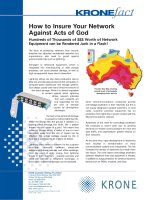DSX Fundamentals Connecting with Your Network
Bạn đang xem bản rút gọn của tài liệu. Xem và tải ngay bản đầy đủ của tài liệu tại đây (228.75 KB, 4 trang )
WHITE PAPER
DSX Fundamentals
Connecting with Your Network
DSX Fundamentals
Connecting with Your Network
Cross-connection encourages seamless expansion, simple
rerouting and quick restoration for today's evolving networks
Reduce costs; increase revenues; satisfy customers—the tenets of service
providers as they balance today’s tenuous financial climate with the promise of
next-generation products and services. And as networks migrate and expand to
include more complex services, reliability and flexibility become even more vital
to their success. That is why digital system cross-connect (DSX) solutions remain
the best option for connecting network elements.
The deployment of DSX platforms eases network expansion; allows circuit access
for nonintrusive testing, monitoring, and patching; and establishes a central
termination point for efficient circuit rearrangements. It allows operators to add
a migration of technological platforms and bring advanced services closer to
customers while preserving integrity at the network’s core.
Make the Connection
Telecommunications networks must be designed to seamlessly absorb new
growth, accommodate wiring changes, and restore failed circuits quickly. In
its journey from source to destination, a signal travels through a gamut of
telecommunications equipment that transforms, grooms, multiplexes, switches,
demultiplexes, and routes the signal. Operators have three accepted methods
of routing this signal: direct connect, interconnect, and cross-connect via a DSX.
Direct connection and interconnection suffer from significant limitations, but the
DSX remains fully capable of providing optimal flexibility, reliability, and access to
the network.
DSX, coupled with a robust connectivity infrastructure, enhances several work
operations:
• Faster service provisioning with greater capacity
• Increased service reliability and protection of electronic equipment and
network elements
• Fundamental maintenance including physical layer access
• Quicker service recovery
• Simple, uncomplicated rollovers in future network migration planning
• Non-intrusive network element replacement and testing
Connectivity typically accounts for 1% to 10% of the upfront costs of network
deployment. A small investment to simplify procedures, reduce errors, and
minimize outages. Many network performance problems stem from restricted
access for maintenance, cable congestion, rerouting or monitoring capabilities.
And each problem is a high-maintenance proposition characterized by longer
service interruptions, operational inefficiency, and frustrated customers that can
be easily averted with a DSX solution.
Page 3
But there is more to connecting a network than simply
running cables between network elements.
Network design plays a crucial role in determining
whether a network will generate revenue or lose
profitability through excess labor costs and missed service
opportunities.
Network design is evaluated against three criteria:
• Flexibility
• Central termination point
• Circuit access
Flexibility
Change is inevitable. In today’s dynamic, evolving
networks, it isn’t a matter of if things will change—it’s a
matter of how much. Today’s communications networks
demand a migration platform equipped with the cable
management and physical rearrangement flexibility to
accommodate new services and network elements.
Today’s networks demand the flexibility of DSX.
Unlike a direct connect solution, where network elements
are directly connected to one another in a dedicated,
pre-assigned method, a DSX solution serves as the
demarcation point. This limits faults to individual circuits
only, allowing changes to be performed with minimal
recabling and labor costs.
Direct connection forces operators to locate cables
and then pull them to new locations, resulting in an
extensive, intrusive reengineering process that demands
a great deal of time and money recabling each network
element. In contrast, a DSX allows operators to simply
remove and replace a small wire on its cross-connect
field to reroute circuits. This quick resolution is critical for
maintaining service even during massive redesigns. It’s
foolish to add new services if existing services are taken
down to do so.
Easier reconfiguration allows operators to manage the
subsequent traffic flow when access to the physical
network layer is required. Technicians can simply patch
into the corresponding circuits with a patch cord for
reconfiguration or monitoring purposes.
Central Termination Point
During network element rearrangements, a DSX can
manage all rerouting, terminating, and maintenance
functions from a centralized location. Without this
centralized termination point, as in direct connection,
cables must be pulled from each network element and
subsequently rerouted to new destinations. Cables soon
litter the central office; tracing becomes difficult; and
labor costs soar. Mining for the physical facilities on
the backplane of a network element is cramped and
time-consuming. This method of hardwiring jeopardizes
reliability and often results in interrupted service because
damage isn’t limited to individual circuits but effects can
quickly spread to all circuits within a shared component
like a common electronic backplane. For instance, a
dropped wrench could knock out an entire network
element, inducing havoc throughout the network.
DSX and interconnect systems allow operators to do
all maintenance and rerouting from one location.
These robust devices protect other, more delicate
equipment from inadvertent damage during the
circuit rearrangement process. And with easy circuit
identification centralized, wiring on network elements’
backplanes remains undisturbed and unharmed.
Circuit Access
A network’s success often depends on how quickly it
adapts to change and the simplicity of its maintenance
capabilities. Networks require physical access points
on every circuit for monitoring, patching, and testing
purposes. The ability to tap into and read the signal on
any circuit—and not interrupt service to customers—is
invaluable in today’s market. By incorporating jacks, DSX
is the only solution that can localize a fault by allowing
operators complete access to any circuit, anytime.
Passing a signal through a jack creates a “window”
into the circuit. Through this window the signal can
be monitored or pulled out, or a new signal can be
introduced, by placing a temporary patch cord into the
corresponding ports. By inserting one end of the patch
cord into a monitor port on the DSX, and the other end
into a test unit or other device, operators can monitor a
signal without interrupting service.
When intrusive testing is required, operators simply plug
the patch cord into the IN/OUT port on the cross-connect
field of the DSX. The signal flow to the cross-connect
field is interrupted and a new connection between the
jack and patch can be made. The signal can then be sent
to a testing device to check for transmission errors or to
another network element to temporarily reroute the signal.
The integration of a DSX into the network allows
operators to patch around faulty circuits quickly and
easily. And operators are given time to restore the
primary circuit without fear of service outages for
customers.
Passing the Test of Time
Networks evolve over time as technology changes and
advanced services are adopted. Equipment obsolescence
and the necessary incorporation of new technologies
present carriers with on-going challenges. When the
customers and the market are ready, the carrier must
move quickly or risk missing revenue opportunity. A
DSX cross-connect point allows deferment of property/
plant and equipment expenses and allows upgrades to
new technologies with the least disruption to current
services. A physical plant with optimal cable management
capabilities encourages quick reconfigurations, upgrades,
and diverse alternate routing. And only through the
cross-connection of network elements will service
providers be able to meet the changing needs of their
networks.
DSX Fundamentals: Connecting with Your Network
Web Site: www.adc.com
From North America, Call Toll Free: 1-800-366-3891 • Outside of North America: +1-952-938-8080
Fax: +1-952-917-3237 • For a listing of ADC’s global sales office locations, please refer to our web site.
ADC Telecommunications, Inc., P.O. Box 1101, Minneapolis, Minnesota USA 55440-1101
Specifications published here are current as of the date of publication of this document. Because we are continuously
improving our products, ADC reserves the right to change specifications without prior notice. At any time, you may
verify product specifications by contacting our headquarters office in Minneapolis. ADC Telecommunications, Inc.
views its patent portfolio as an important corporate asset and vigorously enforces its patents. Products orfeatures
contained herein may be covered by one or more U.S. or foreign patents. An Equal Opportunity Employer
101819AE 12/05 Revision © 2002, 2005 ADC Telecommunications, Inc. All Rights Reserved
WHITE PAPER
Cross-Connect Using a DSX Panel: permanently
terminates equipment cables to a DSX panel via
jacks. Cross-Connection offers optimal flexibilty
and rerouting options and enables intrusive or
nonintrusive access for testing, monitoring, and
patching.
Interconnect: terminates all equipment cables to
connectors on a passive termination block. Central
termination point is established, offering some
flexiblity for rerouting. The lack of circuit access
negates testing, monitoring, and patching.
Direct Connect: elements are directly cabled to
each other without going through an intermediate
termination point—negating flexibility, testing, and
rerouting capabilities









